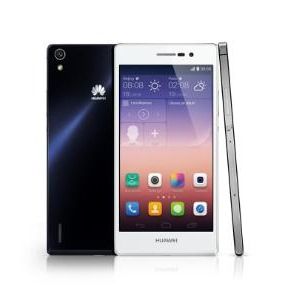While Huawei's presence here in the United States has remained limited, the company's handset shipments in Asia and other parts of the world make it a serious mobile contender in the grand scheme. Today, Huawei announced its latest attempt to usurp its competitors at the high end of the market: the Ascend P7.
The P7 looks largely reminiscent of the P6, which is to say it looks largely reminiscent of an iPhone 4. In fact, it actually looks even more iPhone-ish now that the rear of the phone is covered in a slab of Gorilla Glass. Combined with the 3-sided brushed aluminum banding around the squared-off edges of the device, you have to wonder if there's a reason Huawei hasn't included the US in the list of launch countries.
Apple issues aside, the Ascend P7 is a respectable piece of hardware given its suggested MSRP in Europe, at just 450 Euro. That nets you a 5" 1080p LCD display, 13MP Sony BSI rear camera, 8MP front-facing camera, LTE (with dual antennas), Android 4.4 (with Huawei's Emotion UI 2.3), 2500mAh battery, 2GB of RAM, 16GB of sotrage (with microSD slot), dual microSIM slots, and an in-house 1.8GHz quad-core Huawei processor. OK, that last one might be cause for concern.
Huawei isn't exactly known for its mobile chipsets, but the company has been sticking them inside some of its high-end and China-market-only devices for some time now. The problem is that its silicon is largely untested against the de facto ARM heavyweight Qualcomm, or even smaller competitors like Samsung's Exynos, NVIDIA's Tegra, and Intel's Atom. Huawei uses some level of proprietary design for its cores, but like Samsung it relies on ARM's Mali reference GPU designs which have historically been underperformers against Qualcomm's fully-proprietary Adreno chips. Huawei's strength, though, has been in radio design - the company has arguably the most experience with LTE of any firm, given their massive contracts for cellular equipment and LTE network deployments the world over. The company regularly touts superior data speeds, voice quality, and radio power consumption as part of its device launches.
The list of launch countries for the P7 is as follows: China, the United Kingdom, Germany, Italy, France, Spain, Portugal, Ireland, the Netherlands, Belgium, Switzerland, Poland, Lithuania, Estonia, Latvia, Serbia, Greece, Norway, Hungary, Denmark, Slovakia, Czech Republic, Austria, Hong Kong, Thailand, Malaysia, Philippines, Singapore, Saudi Arabia, Kuwait, and the United Arab Emirates. The phone will ship this month, and some other markets will follow later (again, don't count on the US being one of them).
We may be getting our hands on a P7 to review, so be on the lookout for that in the coming weeks, too.

